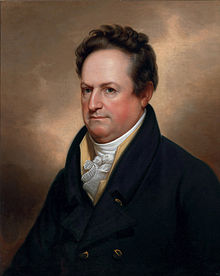
Back ديويت كلينتون Arabic ديويت كلينتون ARZ DeWitt Clinton German DeWitt Clinton Esperanto DeWitt Clinton Spanish دوایت کلینتون Persian DeWitt Clinton Finnish DeWitt Clinton French דוויט קלינטון HE DeWitt Clinton Hungarian
DeWitt Clinton | |
|---|---|
 Portrait by Rembrandt Peale (1823) | |
| 6th Governor of New York | |
| In office January 1, 1825 – February 11, 1828 | |
| Lieutenant | James Tallmadge Jr. Nathaniel Pitcher |
| Preceded by | Joseph C. Yates |
| Succeeded by | Nathaniel Pitcher |
| In office July 1, 1817 – January 1, 1823 | |
| Lieutenant | John Tayler |
| Preceded by | John Tayler (acting) |
| Succeeded by | Joseph C. Yates |
| 47th, 49th and 51st Mayor of New York City | |
| In office 1811–1815 | |
| Preceded by | Jacob Radcliff |
| Succeeded by | John Ferguson |
| In office 1808–1810 | |
| Preceded by | Marinus Willett |
| Succeeded by | Jacob Radcliff |
| In office 1803–1807 | |
| Preceded by | Edward Livingston |
| Succeeded by | Marinus Willett |
| Lieutenant Governor of New York | |
| In office 1811–1813 | |
| Governor | Daniel D. Tompkins |
| Preceded by | John Tayler (acting) |
| Succeeded by | John Tayler |
| United States Senator from New York | |
| In office February 9, 1802 – November 4, 1803 | |
| Preceded by | John Armstrong Jr. |
| Succeeded by | John Armstrong Jr. |
| Personal details | |
| Born | March 2, 1769 Little Britain, New York, British America |
| Died | February 11, 1828 (aged 58) Albany, New York, U.S. |
| Political party | Democratic-Republican |
| Other political affiliations | Federalist (1812) |
| Spouses | Maria Franklin
(m. 1796; died 1818)Catharine Jones (m. 1819) |
| Children | 10, including George W. Clinton |
| Education | Princeton University Columbia University (BA) |
| Signature | |
DeWitt Clinton[a] (March 2, 1769 – February 11, 1828) was an American politician and naturalist. He served as a United States senator, as the mayor of New York City, and as the sixth governor of New York. In the last capacity, he was largely responsible for the construction of the Erie Canal.[1][2] Clinton was a major candidate for the American presidency in the election of 1812, challenging incumbent James Madison.
A nephew of two-term U.S. vice president and New York governor George Clinton, DeWitt Clinton was his uncle's secretary before launching his own political career. As a Democratic-Republican, Clinton won election to the New York State legislature in 1798 before briefly serving as a U.S. Senator. Returning to New York, Clinton served three terms as the appointed Mayor of New York City and the lieutenant governor of New York State. In the 1812 presidential election, Clinton won support from the Federalists as well as from a group of Democratic-Republicans who were dissatisfied with Madison. Though Madison won re-election, Clinton carried most of the Northeastern United States and fared significantly better than the previous two Federalist-supported candidates. After the presidential election, Clinton continued to be affiliated with the Democratic-Republican Party.
Clinton was governor of New York from 1817 to 1822 and from 1825 to 1828, and presided over the construction of the Erie Canal. Clinton believed that infrastructure improvements could transform American life, drive economic growth, and encourage political participation. He heavily influenced the development of infrastructure both in New York State and in the United States as a whole.[3]
Cite error: There are <ref group=lower-alpha> tags or {{efn}} templates on this page, but the references will not show without a {{reflist|group=lower-alpha}} template or {{notelist}} template (see the help page).
- ^ Burrows, Edwin G. "Little Short of Madness". American Heritage (Winter 2010).
- ^ Campbell, William W. (1849). The Life and Writings of De Witt Clinton. New York: Baker & Scribner. ISBN 9780795010972.
- ^ Howe (2007), p. 241
© MMXXIII Rich X Search. We shall prevail. All rights reserved. Rich X Search